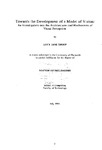Towards the Development of a Model of Vision: An Investigation into the Architectures and Mechanisms of Visual Perception
| dc.contributor.author | TROUP, LUCY JANE | |
| dc.contributor.other | School of Engineering, Computing and Mathematics | en_US |
| dc.date.accessioned | 2013-09-24T10:59:25Z | |
| dc.date.available | 2013-09-24T10:59:25Z | |
| dc.date.issued | 1995 | |
| dc.identifier | NOT AVAILABLE | en_US |
| dc.identifier.uri | http://hdl.handle.net/10026.1/1924 | |
| dc.description.abstract |
A conceptual model of visual perception has been developed using a multidisciplinary approach which combines both top-down and bottom-up descriptions of vision. Top-down psychological theories of visual perception have been investigated resulting in the development of a theory of perception which combines the best of existing accounts. Perception is defined in terms of a combination of "data driven" and "concept driven" explanations. Bottom-up neurophysiological descriptions have also been investigated to provide possible descriptions of structure and function for the development of a conceptual model based upon the theory. An attempt is made to provide a "complete" account of visual perception through the development of both the theory and conceptual model. Further it is envisaged that the development of such a model will provide new insight into the development of artificial vision systems and new algorithms for perceptual function in such systems. | en_US |
| dc.language.iso | en | en_US |
| dc.publisher | University of Plymouth | en_US |
| dc.title | Towards the Development of a Model of Vision: An Investigation into the Architectures and Mechanisms of Visual Perception | en_US |
| dc.type | Thesis | en_US |
| plymouth.version | Full version | en_US |
| dc.identifier.doi | http://dx.doi.org/10.24382/1339 | |
| dc.identifier.doi | http://dx.doi.org/10.24382/1339 |
Files in this item
This item appears in the following Collection(s)
-
01 Research Theses Main Collection
Research Theses Main


